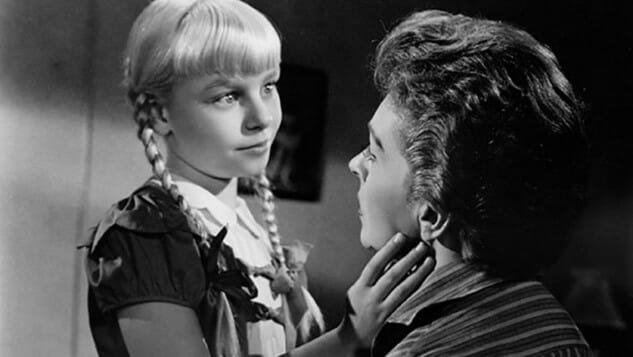The Best Horror Movie of 1956: The Bad Seed

This post is part of Paste’s Century of Terror project, a countdown of the 100 best horror films of the last 100 years, culminating on Halloween. You can see the full list in the master document, which will collect each year’s individual film entry as it is posted.
The Year
1956 is perhaps a touch weaker than the years that surround it, where we wouldn’t bother putting the likes of The Creature Walks Among Us into the list of honorable mentions, but thanks to a handful of classics it’s still a fairly strong year overall.
Yet another adaptation of The Hunchback of Notre Dame graced the silver screen this year, this time starring Anthony Quinn as Quasimodo, but it’s less consequential than either the Charles Laughton or Lon Chaney versions of the same story. More accurately capturing the current zeitgeist is Earth vs. the Flying Saucers, which borrows the motifs of The War of the Worlds but capitalizes on the real life saucer craze of the era, brought to life through Ray Harryhausen’s state-of-the-art effects. The film contains numerous stop-motion FX shots that are now classics, especially the entire UFO attack on Washington D.C., which includes the sight of a crashing saucer smashing its way through the Washington Monument, which splinters like a toothpick. Harryhausen’s designs for the saucers themselves would become genre staples in their own right, as the static central cabin and rotating outer disc were often used as shorthand descriptions for a “typical” UFO, themselves symbols of 1950s science fiction.
It’s Invasion of the Body Snatchers, though, that stands as 1956’s other gem. Don Siegel’s film is the first of several adaptations of Jack Finney’s 1954 novel The Body Snatchers, and although it lacks some of the more stomach-churningly weird sights of Philip Kaufman’s 1978 remake (like that man-faced dog!), it makes up for it with solid performances and its uniquely bright, complacent portrayal of human society being destroyed from within. As so many others have observed since the film’s first release, it’s the ultimate Red Scare-era parable for the coming conflict of East vs. West, emotionless collectivist vs. passionate individualist cultures, tapping into the simmering fear that the nation’s very identity was being secretly undermined by outsiders. The fact that the assimilations and “pod people” creations happen while we sleep only deepens the metaphor, implying the need for constant, ceaseless vigilance. Of course, these themes have kept Invasion of the Body Snatchers painfully relevant at any time in American history when xenophobia is running rampant, today being no exception. Embroiled as we are in another culture war revolving around oft-racist accusations of “un-American” behavior, there’s never been a better time to revisit the film than right now.
1956 Honorable Mentions: Invasion of the Body Snatchers, Rodan, Earth vs. the Flying Saucers, The Hunchback of Notre Dame, The Creature Walks Among Us, X the Unknown
-

-

-

-

-

-

-

-

-

-

-

-

-

-

-

-

-

-

-

-

-

-

-

-

-

-

-

-

-

-

-

-

-

-

-

-

-

-

-

-








































